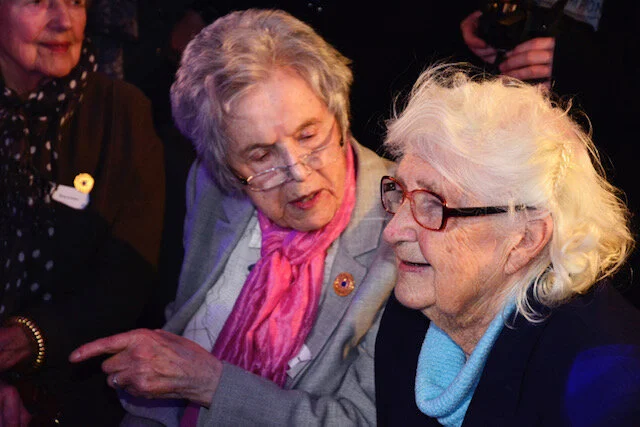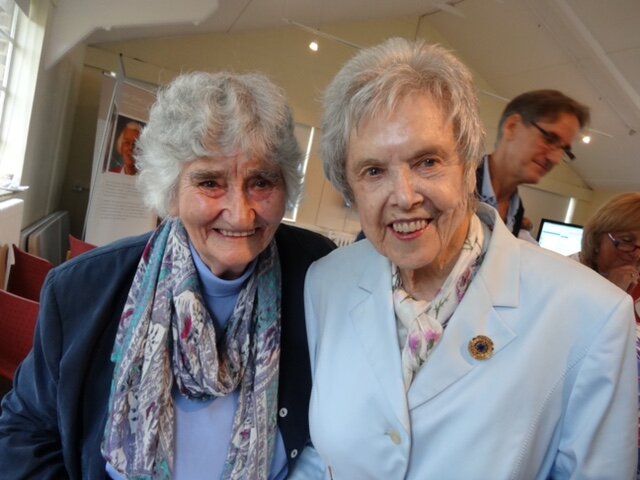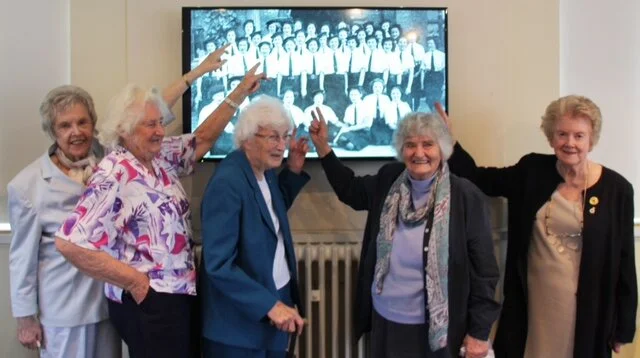Betty O’Connell, 1925–2021
/Margaret (Betty) O’Connell (née Oliver), one of the last known surviving connections with the second world war codebreaking machine Colossus Mk I, has died, one day before her 96th birthday.
Because of the second world war, Betty could not take up her place at university and, aged 17, she volunteered as a Wren (a member of the Women’s Royal Naval Service). Partly because of her ability to solve crossword puzzles, she was selected to work at Bletchley Park in 1942 in the Newmanry, a section recently set up under Max Newman to automate codebreaking.
Betty O’Connell (standing right) with fellow wartime C Watch Wrens, Lorna Cockayne and the late Joanne Chorley) in front of the Colossus rebuild.
Photo: John Robertson
Posted to HMS Pembroke, a landlocked cabin on the nearby Woburn Estate, she was in the first team that operated Colossus Mk I and later became a member of Colossus C Watch on Bletchley Park (a single photograph that came to light a few years ago showing Betty in the C Watch).
First operational in December 1943, Colossus Mk I started breaking German Lorenz messages in February 1944. One of Betty’s key roles was to load and unload the precious paper message data tapes, that had taken hours of meticulous work to create. At the time Betty knew her work was important, but she did not know how important – the Lorenz-encrypted messages she was helping to decipher were strategic messages between Hitler and his generals.
Betty O’Connell (left) discussing the workings of Colossus with Lorna Cockayne in front of the Colossus rebuild,
Having signed the Official Secrets Act, Betty like others at Bletchley Park could not divulge anything about her work for decades. When she was finally permitted to speak of her work, her first response to eager family questioning was delivered in a low voice and with a twinkle in her eye: “do you know, dear, I really can’t remember!”
In recent years, Betty did begin to talk more about her work, especially when memories were rekindled by a reunion celebrating the 70th anniversary of Colossus at The National Museum of Computing (TNMOC) on Bletchley Park. After seven decades, she met up again with fellow HMS Pembroke Wren and Colossus Mk I operator Irene Dixon. Their friendship was reignited instantly and for almost seven years, until Irene’s death in January 2021, they were in almost daily contact, emailing by iPad.
Betty O’Connell (right) on the day in 2014 she was reunited with former Wren and friend Irene Dixon.
Photo: Philip Le Grand
The memories of Betty and Irene have done much to inspire the general public and visitors to TNMOC. On one memorable occasion, they made an impromptu appearance before a group of women in computing at TNMOC and held them enthralled. As a double act, they were inspirational whether giving their reactions after seeing at close quarters an original Lorenz cipher machine for the first time (it was newly arrived from Norway ready to be displayed at TNMOC), on the Jeremy Vine Show on BBC Radio 2 or at a presentation to young female school pupils at an event promoting women in computing at Oxford University. Betty also appeared on BBC1 The One Show with other Colossus Wrens and, together with son Patrick, promoted the book Lorenz by friend and wartime codebreaker the late Captain Jerry Roberts at the Cheltenham Literature Festival.
Betty was the second of four children born to Christopher and Ann Oliver in Coventry. Her intelligence, sense of humour and some would say impishness shone through from an early age. As a girl she was very active on the family farm in Cumbria and at school she was captain of the hockey, tennis and cricket teams, going on to become head girl. Her grandmother, concerned that Betty was developing into rather too much of a tomboy, bought her a pair of shoes with heels. Betty promptly took them to the farm workshop to saw off the heels.
Betty met her future husband, Guy, playing tennis in Putney 1958 and they went on to have three children. In 1974, she moved with Guy to Teheran, where he had been posted, but after his unexpected death in 1977, she returned to England and took up employment to support her children through their education.
In a self-deprecating assessment that will resonate with anyone who knew her, Betty spoke of her personal suitability for a particular job: “I joined the electric vehicle association with some trepidation, knowing absolutely nothing about electric vehicles. However, I was encouraged by my family, who thought I had many of the attributes of a battery: ever-ready, highly charged, expensive to replace, portable and not given to gassing.”
Betty’s crossword skills, part of the reason she was selected for Bletchley work, never left her – three days before her death, she was still deciphering the answers.
Betty is survived by her three children, Liz, James and Patrick and four grandchildren, Holly, Jo, Charity and Anna.
Betty O’Connell (left) and other former Wrens in 2014 pointing to themselves in a 1940s photo of Colossus C Watch






